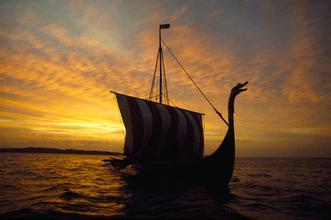Think you've got the Vikings pegged? With all the caricatures and stereotypes out there, there's probably a lot you've never heard about the seafaring Scandinavians who raided and settled coastal sites in the British Isles and beyond between the ninth and 11th centuries. Explore 10 surprising facts about the Vikings below.
你是否意识到“维京人”在你的思维中已经被贴上了标签?在漫画和定式思维的影响下,关于这些在九世纪到十一世纪之间,侵略了大不列颠岛以及更远的一些邻海地域,并在当地定居的维京人,也许还有许多事实是你不知道的。下面,就让我们一起探索关于维京人的10个惊人事实吧!

1. Vikings didn't wear horned helmets.
1. 维京人并没有戴角盔的习惯
Forget almost every Viking warrior costume you've ever seen. Sure, the pugnacious Norsemen probably sported headgear, but that whole horn-festooned helmet look? Depictions dating from the Viking age don't show it, and the only authentic Viking helmet ever discovered is decidedly horn-free. Painters seem to have fabricated the trend during the 19th century, perhaps inspired by descriptions of northern Europeans by ancient Greek and Roman chroniclers. Long before the Vikings' time, Norse and Germanic priests did indeed wear horned helmets for ceremonial purposes.
忘掉你看到的每一套维京战士服装吧!当然,好战的北欧人也许有戴帽子的习惯,但一定是绑有角的吗?维京人时期的壁画并没有描绘这样的角盔,而唯一所挖掘出来的真实头盔是没有角的。在古希腊人和罗马编年史对古代北欧人所做的描述的影响之下,画家们也许是对十九世纪的”潮流”进行了自由发挥。而远早于维京人时期的挪威和日耳曼牧师们,的确会在仪式上戴角盔。
2. Vikings were known for their excellent hygiene.
2. 维京人对卫生的注重远近驰名
Between rowing boats and decapitating enemies, Viking men must have stunk to high Valhalla, right? Quite the opposite. Excavations of Viking sites have turned up tweezers, razors, combs and ear cleaners made from animal bones and antlers. Vikings also bathed at least once a week—much more frequently than other Europeans of their day—and enjoyed dips in natural hot springs.
除了驾船和斩首敌人,维京男人们就只能在瓦尔哈拉宫(尘世阵亡的英雄的住所)里发出恶臭?恰恰相反,在对维京人居住地的挖掘过程中,考古学家们发现了由动物骨头和鹿角制作的镊子、刮胡刀、梳子,以及耳勺。维京人每周至少沐浴一次--远比同一时期的其他欧洲人频繁得多--并且懂得享受纯原生态的温泉。
3. Vikings used a unique liquid to start fires.
3. 维京人用一种特殊的液体生火
Clean freaks though they were, the Vikings had no qualms about harnessing the power of one human waste product. They would collect a fungus called touchwood from tree bark and boil it for several days in urine before pounding it into something akin to felt. The sodium nitrate found in urine would allow the material to smolder rather than burn, so Vikings could take fire with them on the go.
维京人虽然是”洁癖怪人”,但他们却能够很好的利用人类所产生的废物。维京人会从树皮上收集一种叫做火绒的真菌,并在尿液中将火绒沸煮几天,再将其捶打至与原来相似的物质。尿液中的硝酸盐会使物质慢慢燃烧而不是迅速的烧尽,所以维京人可以持续的使用这种物质生火。
4. Vikings buried their dead in boats.
4. 维京人将尸体葬于船中
There's no denying Vikings loved their boats—so much that it was a great honor to be interred in one. In the Norse religion, valiant warriors entered festive and glorious realms after death, and it was thought that the vessels that served them well in life would help them reach their final destinations. Distinguished raiders and prominent women were often laid to rest in ships, surrounded by weapons, valuable goods and sometimes even sacrificed slaves.
无法否认,维京人极爱他们的船--以至于他们认为被葬在船里是一个极大的荣耀。在北欧地区,勇敢的战士们有资格进入荣耀之地,而他们生前所使用的战船会送他们到最终的回归之地。优秀的战士和杰出的女性常常在武器、珍贵的货物,甚至是陪葬奴隶的围绕下,安息于船中。
5. Vikings were active in the slave trade.
5. 维京人在奴隶交易中非常活跃
Many Vikings got rich off human trafficking. They would capture and enslave women and young men while pillaging Anglo-Saxon, Celtic and Slavic settlements. These “thralls,” as they were known, were then sold in giant slave markets across Europe and the Middle East.
许多维京人通过贩卖人口致富。当他们入侵了盎格鲁-撒克逊人(生活在大不列颠东部、南部)、凯尔特人或者斯拉夫人的居住地之后,会抓住当地的女人和年轻男人作为奴隶。这些所谓的”奴隶”会被贩卖于跨越欧洲和中东的巨大奴隶交易市场之中。
6. Viking women enjoyed some basic rights.
6. 维京女人们享有一些基本权利
Viking girls got hitched as young as 12 and had to mind the household while their husbands sailed off on adventures. Still, they had more freedom than other women of their era. As long as they weren't thralls, Viking women could inherit property, request a divorce and reclaim their dowries if their marriages ended.
维京女孩在12岁时就会”绑”住:嫁做人妇、在丈夫外出航行时看家。但她们相比同时代的女性有更多的自由。只要她们不是奴隶,维京女人就能够继承财富、主动提出离婚,并在婚约解除之时要求拿回她们的嫁妆。
7. Viking men spent most of their time farming.
7. 维京人生活中的大多数时间都在务农
This may come as a disappointment, but most Viking men brandished scythes, not swords. True, some were callous pirates who only stepped off their boats to burn villages, but the vast majority peacefully sowed barley, rye and oats—at least for part of the year. They also raised cattle, goats, pigs and sheep on their small farms, which typically yielded just enough food to support a family.
这也许是挺让人失望的一件事,维京男人们最经常使用的不是剑,而是镰刀。没错,有些维京人的确是冷酷无情的海盗,只会烧杀抢夺,但大多数人还是在种植大麦、黑麦和燕麦——至少一年中总会有一段时间都在这样做。他们也在自己的小农场中饲养牛、山羊、猪和绵羊,而这些常常只够他们恰好养活一家人。
8. Vikings skied for fun.
8. 维京人以滑雪为乐
Scandinavians developed primitive skis at least 6,000 years ago, though ancient Russians may have invented them even earlier. By the Viking Age, Norsemen regarded skiing as an efficient way to get around and a popular form of recreation. They even worshipped a god of skiing, Ullr.
虽然古俄罗斯人比斯堪的纳维亚人更早发明滑雪橇,但早在6000年前,斯堪的纳维亚人(主要是指生活于古代北欧地区的人)已经发展出了极其精美的滑雪橇。直到维京时期,北欧人们都把滑雪视为一种有效的交通方式,同时也是一种受欢迎的娱乐方式。他们甚至崇拜滑雪之神--乌勒尓。
9. Viking gentlemen preferred being blond.
9. 维京绅士们更偏好把头发弄成浅色
To conform to their culture's beauty ideals, brunette Vikings—usually men—would use a strong soap with a high lye content to bleach their hair. In some regions, beards were lightened as well. It's likely these treatments also helped Vikings with a problem far more prickly and rampant than mousy manes: head lice.
为符合他们的审美观,深棕色的维京人--通常是男性--会使用一种含有强碱性物质的肥皂漂白他们的头发。在某些地区,胡子也会被漂白。这种处理方式似乎能够解决维京人原本头发还是灰褐色时,无法控制且令他们无时无刻感到刺痛的难题:头虱。
10. Vikings were never part of a unified group.
10. 维京人并非是一个集体
Vikings didn't recognize fellow Vikings. In fact, they probably didn't even call themselves Vikings: The term simply referred to all Scandinavians who took part in overseas expeditions. During the Viking Age, the land that now makes up Denmark, Norway and Sweden was a patchwork of chieftain-led tribes that often fought against each other—when they weren't busy wreaking havoc on foreign shores, that is.
维京人并不承认他们的同胞。事实上,也许他们根本不称呼他们自己为维京人--特指所有参与海外征途的斯堪的纳维亚人。在维京人时期,现在丹麦、挪威和瑞典组成的地域是由各个酋长领导的部落组成,当他们不再忙于在外国海岸烧杀抢夺时,他们就会相互入侵。
注:本文章转载自前十网,译者张秋月












